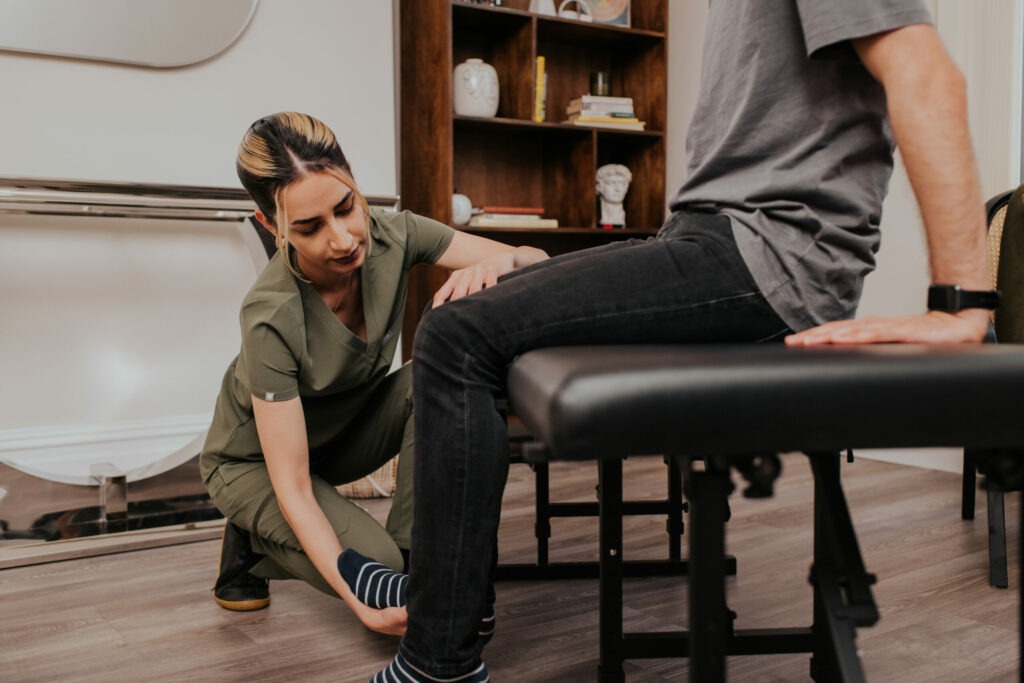Ankle
Sprained Ankle
Sprain is a stretch and/or tear of a ligament and it typically affect the ankles, knees and wrists. Lateral ankle sprains are the most common injury especially in physically active people with approximately 1 million ankle sprains occur per year in the UK. Sprained ankle symptoms include:
- Pain around the joint and on weight-bearing
- Swelling and bruising
- Instability (a perception of giving away)
- Trouble walking
Initial self-management strategies for the first 48-72 hrs include: protection from further injury by using a support, rest, ice, compression with an elastic bandage and keeping the injured area elevated and support on a pillow. Some people have a higher risk of developing ankle sprains, these risk factors include:
- History of previous injury: Ankle sprains had one of the highest reinjury rates of all the lower limb musculoskeletal injuries, with up to a 2-fold increased risk of reinjury in the year after injury.
- Inadequate strength of the ankle and hip joint muscle may increase the risk of developing an ankle sprain
- Poor static and dynamic postural balance

Achilles Tendinopathy
Achilles tendinopathy is a common overuse injury that causes pain, swelling and stiffness of the Achilles tendon which is the thickest and strongest tendon in the body. According to the National Institute for Health and Care Excellence (NICE), this injury has an increasing incidence, which may be due to increased sporting activities and more intense training. it is estimated to affect more than 150,000 people in the UK every year and is more common in runners, especially middle-aged long-distance runners.
For Achilles tendinopathy, risk is multifactorial and related to tendon overloading, general risks include:
- Age: Achilles tendinopathy is most common from the age of 30 onwards
- Sports such as running, tennis, squash and those involving repetitive jumping, or burst of sprinting
- Changes in training such as increased interval training, distance or using sloping surfaces
- Diabetes
- History of injuries
- Footwear
Managing Achilles tendinopathy include:
- Ice ack to ease symptoms after acute injury
- Rest
- NSAIDS may be useful for pain relief in acute phase, but it is not recommended in the longer term.
- Eccentric exercise as part of the rehabilitation
- Extracorporeal shock-wave therapy
Biomechanical evaluation of the foot and leg is clinically essential in Achilles management as modification of foot posture in some people can reduce pain and increase the capacity to load the tendon. Surgery may be indicated in chronic cases and people who have not respond to conservative treatment.
What Our Clients Say

I got in touch with osteoandspinal after my second knee surgery as I was concerned about my recovery. After my initial consultation, Mahsa explained the issue and laid out a thorough plan for rehabilitating my knee. Following the recommended exercises and after a few adjustments, I’m already feeling stronger and more confident. I am very pleased with the results and would highly recommend osteoandspinal clinic.
Aryan R

I can’t recommend this place enough! I visited osteoandspinal during my pregnancy when I developed a severe back pain. Mahsa made me feel comfortable and at ease by explaining all aspects of the treatment. Over the next couple of visits, she managed to reduce the pain through adjustments and acupuncture.
Sophia O
Ready To Book?
If you would like to arrange an appointment you can book online by clicking below. Alternatively you can get in touch with us on 07464 637437 or reception@osteoandspinal.co.uk
